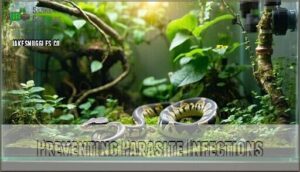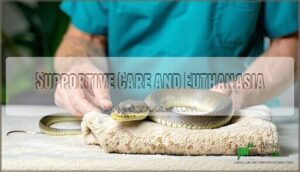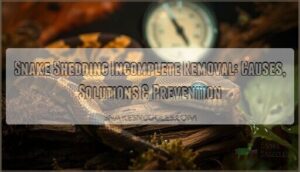This site is supported by our readers. We may earn a commission, at no cost to you, if you purchase through links.

Ivermectin and fenbendazole are go-to dewormers that tackle most internal parasites, while permethrin spray handles external mites.
Don’t play guessing games with dosages—snake physiology isn’t forgiving like mammals.
Your vet will determine the right medication based on fecal testing and parasite identification.
Temperature control during treatment helps medications work better, and you’ll need follow-up testing to confirm success.
Think of it as a targeted strike rather than carpet bombing—precision matters when your scaly friend’s health is on the line.
The treatment arsenal extends beyond these basics to ensure comprehensive care, emphasizing the importance of veterinary-prescribed medications for effective treatment, and considering the unique aspects of snake physiology.
Table Of Contents
- Key Takeaways
- Snake Parasite Symptoms
- Parasite Transmission Risks
- Preventing Parasite Infections
- Common Snake Parasite Treatments
- Effective Treatment Options
- Frequently Asked Questions (FAQs)
- What is the best dewormer for snakes?
- What is the most effective treatment for parasites?
- How do you treat pinworms in reptiles?
- What does ivermectin treat in snakes?
- How often should snakes receive parasite testing?
- Can parasites affect snake breeding success rates?
- Whats the cost of professional parasite treatment?
- Are wild-caught snakes more parasite prone?
- Do different snake species require different treatments?
- Conclusion
Key Takeaways
- You’ll need veterinary-prescribed medications like ivermectin and fenbendazole—don’t guess on dosages since snake physiology isn’t forgiving like mammals
- You can’t skip fecal testing and parasite identification before treatment because targeted therapy works better than guesswork
- You’ll want to maintain proper temperature control during treatment and follow up with testing to confirm the parasites are gone
- You should focus on prevention through strict quarantine protocols, regular hygiene, and professional screening rather than just treating infections after they happen
Snake Parasite Symptoms
Recognizing parasite symptoms early can save your snake‘s life and prevent serious health complications.
You’ll notice several telltale signs when parasites invade your pet’s system, ranging from obvious physical changes to subtle behavioral shifts that require a trained eye to spot, including parasite symptoms.
Visible Signs of Infection
When checking for snake parasite symptoms, you’ll spot telltale signs like scale abnormalities and unusual skin texture changes.
Look closely for mite identification – tiny moving dots on your snake’s body.
Visible worms may appear in feces or vomit during fecal examination.
Lethargy signs include reduced movement and poor shedding patterns, indicating your snake’s health needs immediate attention for proper snake diagnosis and care.
Behavioral Changes in Snakes
When dealing with snake parasite symptoms, you’ll notice your pet’s behavior shifts dramatically.
Infected snakes often become lethargic and withdrawn, preferring to hide rather than explore their environment like they normally would.
- Lethargy and reduced activity – Your snake may spend excessive time motionless, showing little interest in normal behaviors
- Agitation and erratic movements – Some snakes exhibit restless behavior, constantly moving or rubbing against objects to relieve discomfort
- Hiding behavior changes – Infected snakes often retreat to hiding spots more frequently, avoiding interaction and regular activities
Abnormal Stools and Diarrhea
Stool consistency becomes your first red flag when internal parasites invade your snake’s digestive system.
You’ll notice watery, loose bowel movements replacing normal, well-formed waste.
Color changes from brown to yellow, green, or bloody indicate serious intestinal parasites causing inflammation.
Frequency issues develop as snake diarrhea disrupts normal elimination patterns.
Dehydration risks increase rapidly with persistent loose stools.
Diagnostic testing through fecal examination confirms snake worms and identifies specific parasite types requiring targeted treatment.
The presence of internal parasites can lead to severe health issues, and it is crucial to address the problem promptly to prevent further complications, including serious intestinal parasites.
Weight Loss and Poor Appetite
Two out of three infected snakes show noticeable weight loss and poor appetite as their bodies battle internal parasites.
Metabolic issues arise when snake worms steal essential nutrients, leading to anorexia causes that compound malnutrition effects.
Digestive problems create stress factors that further suppress your snake’s natural feeding response, making snake parasite treatment essential for restoring healthy snake diet patterns.
Vomiting and Regurgitation
Beyond appetite loss, you’ll notice your snake bringing up undigested food or clear fluids. Parasitic infections disrupt normal digestion, making your pet unable to keep meals down. Snake regurgitation differs from vomiting – it’s typically undigested prey expelled shortly after feeding.
Key regurgitation patterns in infected snakes:
- Frequency – Multiple episodes within days of feeding attempts
- Causes – Internal parasites irritating digestive tract walls
- Diagnosis – Vet examination reveals underlying parasite load
- Management – Snake parasite treatment stops recurring episodes
Complications from untreated regurgitation include severe snake weight loss and dehydration, requiring immediate snake parasite diagnosis.
Parasite Transmission Risks
You’re at risk of catching parasites from your snake through several transmission routes that require careful attention.
Understanding these pathways helps you protect both yourself and your reptile from dangerous infections that can spread between species.
Zoonotic Risk to Humans
Some snake parasites pose serious zoonotic risks to humans through multiple transmission pathways.
Snake parasites can jump from your reptile to you—proper handling prevents dangerous infections.
You’re most vulnerable through fecal-oral contact, handling infected reptiles, or consuming undercooked snake meat. Certain parasites like Salmonella affect 6% of human cases, while pentastomids cause severe respiratory reactions.
Preventing the spread of reptile parasitic diseases is essential for public health.
| Parasite Type | Human Infection Routes | Symptom Overlap |
|---|---|---|
| Salmonella | Fecal contamination, surface contact | Diarrhea, fever, vomiting |
| Pentastomids | Respiratory secretions, contaminated soil | Coughing, chest pain, breathing issues |
| Cryptosporidium | Direct fecal contact, water sources | Digestive upset, dehydration |
| Sparganosis | Raw meat consumption, wound contact | Organ migration, neurological symptoms |
| Entamoeba | Environmental contamination, direct handling | Intestinal distress, systemic infection |
Preventative human measures include proper hand hygiene, avoiding face contact after handling, and never consuming raw reptile products.
The public health impact remains significant in pet-owning households and cultural communities practicing traditional snake consumption.
Contaminated Environments and Objects
Around every corner, contaminated environments create perfect breeding grounds for snake parasites.
Dirty enclosures harbor parasite eggs that survive for weeks on surfaces.
Infected substrates and contaminated water sources spread diseases rapidly throughout your collection.
Filthy feeding areas become transmission hotspots where tainted decorations collect microscopic threats.
Even after removing sick snakes, salmonella persists on clothing and equipment, creating ongoing reptile parasite control challenges that demand immediate parasite prevention action, posing significant risks to the health of your reptile collection.
Infected Feeder Insects
Cricket parasites pose one of the biggest threats to your snake’s health.
These feeder insects commonly carry pinworms that transfer directly to your pet during feeding.
You can slash this risk by switching to roach alternatives like dubia roaches, which carry fewer parasites.
Gut loading insects properly and freezing feeders overnight kills potential threats.
Consider prekilled frozen prey for complete parasite prevention, as this method ensures the feeders do not carry any parasites.
Contact With Infected Reptiles
Direct handling of infected reptiles creates the highest risk for parasite transfer through skin contact and contaminated surfaces.
Every snake you touch without proper precautions becomes a potential disease carrier threatening your entire collection.
You’ll face cross infection when touching snakes carrying pentastomids, cryptosporidium, or salmonella** without proper reptile hygiene protocols.
Immediate reptile isolation prevents parasitic infections from spreading throughout your collection, while thorough handwashing after contact reduces transmission risks substantially.
Imported Snake Risks
Importing exotic snakes brings hidden dangers you can’t see.
These reptiles often carry novel parasitic infections without showing symptoms, making snake screening essential.
Border control measures help, but quarantine protocols remain your best defense against import risks.
Effective snake parasite management requires thorough parasite testing before introducing new reptiles to your collection, preventing devastating parasitic infections.
Preventing Parasite Infections
You can’t treat what you can’t prevent, so establishing solid defense strategies against parasites becomes your first line of protection for your snake’s health.
Prevention requires a multi-layered approach that combines proper quarantine protocols, strict hygiene practices, and regular veterinary screening to keep these unwanted invaders at bay.
Strict Sanitation and Hygiene
Your snake’s health depends on maintaining spotless hygiene practices and rigorous sanitation protocols.
Clean enclosures weekly with 0.15% bleach solution, allowing 15-minute contact time for disease prevention. Wash hands thoroughly after handling, use dedicated equipment for each snake, and perform daily spot-cleaning of waste.
Environmental cleaning isn’t just housekeeping—it’s your first line of defense against reptile parasite hygiene issues.
Proper snake enclosure cleaning techniques are essential for preventing the spread of diseases and maintaining a healthy environment.
Quarantine and Parasitological Screening
New reptiles harbor hidden dangers that can devastate your entire collection.
You’ll need to isolate newcomers for three months minimum using dedicated equipment and separate enclosures.
During snake quarantine, perform fecal testing to detect parasites through parasitological screening methods.
These quarantine protocols include multiple screenings since some parasites won’t show up immediately.
Isolation techniques prevent cross-contamination while allowing thorough parasite detection before introducing new animals to prevent cross-contamination and ensure thorough parasite detection.
Proper Husbandry and Terrarium Hygiene
Smart enclosure maintenance creates your first defense against snake parasites and reptile health issues.
Clean terrarium surfaces weekly with reptile-safe disinfectants, replacing substrates monthly to prevent parasite buildup.
Daily spot-cleaning removes waste that harbors harmful organisms, while proper ventilation and temperature control discourage parasite proliferation in your snake’s habitat.
Effective reptile cleaning products, such as those found in reptile care, are essential for maintaining a healthy environment with proper ventilation and temperature control.
Expert Advice and Guidance
Professional veterinary care forms the backbone of effective parasite control in snake health management.
You can’t wing it when dealing with parasitic infections—reptile medicine requires specialized expertise that general pet vets might lack.
Seek veterinarians experienced in snake parasites who’ll conduct proper fecal screenings and recommend targeted reptile parasite treatment options.
Their expert guidance guarantees you’re using the right snake parasite treatment protocols safely.
Understanding parasite control methods is vital for preventing the spread of diseases in captive snakes.
Common Snake Parasite Treatments
When your snake shows signs of parasitic infection, you’ll need professional veterinary treatment to safely eliminate these unwelcome hitchhikers.
Treatment options range from targeted medications like anthelmintics to environmental adjustments, with your vet selecting the best approach based on the specific parasite type and your snake’s condition.
Anthelmintic Therapy and Deworming
Effective anthelmintic therapy starts with proper veterinary diagnosis through fecal testing.
Your vet will prescribe targeted deworming medications like fenbendazole (25-100 mg/kg) or levamisole (5-10 mg/kg) based on the specific parasitic worm identified.
These snake medications require precise dosing and timing—typically administered every 14 days for ideal parasite removal and successful treatment outcomes.
Chemotherapeutic Agents and Medications
Beyond basic deworming, targeted chemotherapeutic agents tackle specific parasites effectively.
Your veterinarian will select medications based on your snake’s parasite type and health status.
Key Chemotherapeutic Options:
- Praziquantel Use – Eliminates tapeworms and flukes at 8 mg/kg, repeated after 14 and 28 days
- Metronidazole – Combats protozoan infections at 20-40 mg/kg for 2-5 treatments
- Sulfadimethoxine – Treats coccidia over 2-4 weeks with careful monitoring
- Paromomycin – Reduces cryptosporidiosis symptoms at species-specific dosages
Understanding parasite control methods is essential for effective treatment.
Medication Safety remains paramount – never attempt self-treatment without professional guidance.
Environmental Temperature Control
When dealing with certain parasitic infections, you’ll need to adjust your snake’s environmental conditions as part of the treatment plan.
Temperature regulation becomes essential for combating specific parasites like spirurid worms.
Heat sources should maintain thermal gradients between 95°-98°F for 24-48 hours, creating inhospitable conditions for these invaders.
However, humidity control and overall climate management require careful monitoring during this intensive heat therapy to prevent stress-related complications in your reptile.
Supportive Care and Euthanasia
When severe parasitic infections overwhelm your snake’s system, supportive care becomes the compassionate path forward.
Sometimes letting go is the kindest choice for suffering reptiles.
- Palliative Care: Maintain comfortable temperatures and hydration levels
- End Life Assessment: Monitor for irreversible organ damage or chronic pain
- Comfort Measures: Reduce handling stress during final stages
- Humane Killing: Veterinary euthanasia prevents prolonged suffering
Specific Medications for Parasite Types
Different parasites require targeted medications for effective elimination.
Fenbendazole treatment works against roundworms at 25-100 mg/kg every 14 days, while ivermectin therapy targets mites and ticks at 200 mcg/kg.
Levamisole handles lungworms effectively, and praziquantel eliminates tapeworms.
Your vet will match specific anthelmintics to your snake’s parasite type for ideal deworming options and successful parasitic treatment outcomes.
Effective Treatment Options
You’ll need to match the right medication to your snake’s specific parasite type for the best results.
Working closely with your reptile veterinarian guarantees proper dosing and monitoring throughout the treatment process.
Ivermectin and Fenbendazole Administration
You’ll find that ivermectin and fenbendazole work together like a one-two punch against snake parasites treatment.
These reptile parasitic infections require precise medication dosage – ivermectin targets mites while fenbendazole eliminates nematodes.
Combined therapy shows superior treatment efficacy compared to single-drug approaches, making these administration guidelines your go-to deworming methods for thorough parasite control.
- Double the power – Combined ivermectin-fenbendazole therapy destroys more parasites than either drug alone
- Flexible dosing – Fenbendazole 10% liquid lets you customize treatment from single doses to multi-day protocols
- Precision matters – Ivermectin’s narrow therapeutic window means careful dosing prevents toxicity
- Proven results – This combination specifically targets stubborn trichurid parasites that resist single treatments
- Professional confidence – Veterinary-grade parasitic treatment options give you peace of mind for your snake’s health
Levamisole and Ponazuril Treatment
While ivermectin and fenbendazole tackle many parasites, levamisole targets stubborn nematodes that resist other treatments.
You’ll administer levamisole at 5-10 mg/kg via oral or subcutaneous routes, repeating every 14 days.
However, debilitated snakes face neurotoxicity risks from its nicotine-like effects, so avoid using it with kidney or liver issues.
| Treatment Aspect | Levamisole | Ponazuril |
|---|---|---|
| Primary Target | Nematodes, lungworms | Coccidia, protozoans |
| Levamisole Dosage | 5-10 mg/kg oral/SC | 30 mg/kg oral |
| Treatment Duration | Every 14 days | Every 48 hours |
| Parasite Resistance | Moderate effectiveness | High efficacy |
| Medication Safety | Neurotoxic if debilitated | Generally well-tolerated |
Ponazuril offers superior ponazuril efficacy against coccidia in bearded dragons and other reptiles.
Unlike levamisole’s harsh side effects, ponazuril maintains excellent medication safety profiles.
Always monitor your snake’s condition during treatment – if they’re acting sluggish or refusing food, contact your reptile vet immediately.
Serial fecal exams verify treatment success and detect any developing parasite resistance.
Effective fungal disease management is essential for preventing the spread of infections in snake populations.
Imidocarb Dipropionate and Sulfadimethoxine
Two powerful chemotherapy options target stubborn blood-borne parasites in your snake.
Imidocarb dipropionate serves as the gold standard for hepatozoonosis at 5 mg/kg subcutaneously, while sulfadimethoxine tackles coccidia at 30 mg/kg daily for 2-4 weeks.
You’ll need atropine alongside imidocarb to prevent muscarinic side effects, and adequate hydration prevents sulfadimethoxine’s kidney toxicity.
Permethrin Spray and Ivermectin Environmental Sprays
Permethrin spray offers licensed protection against mite control and tick removal in reptiles. You’ll apply this parasiticide at 12-15 inch distances using specific protocols for effective environmental treatment.
Follow these permethrin application steps:
- Spray substrate – Apply 1-second bursts per square foot across terrarium surfaces
- Maintain distance – Keep spray nozzle 12-15 inches from treated areas
- Allow drying – Wait for complete surface drying before snake reintroduction
- Dilute if needed – Mix 1:2 water ratio for smaller reptiles’ safety
Ivermectin environmental sprays (5-10mg/L water) complement permethrin for thorough reptile hygiene. Apply every 3-5 days targeting snake parasite treatment zones.
This dual approach maximizes parasite spray effectiveness while maintaining reptile parasites elimination protocols. For ideal results, consider using Permethrin spray products to guarantee effective mite control and tick removal in reptiles.
Monitoring and Follow-up Care
After applying permethrin spray treatments, you’ll need ongoing snake monitoring to guarantee success.
Serial fecal testing every 60 days verifies treatment effectiveness against parasites. Follow-up care includes regular health checks and parasite screening to catch any missed infections.
| Monitoring Schedule | Action Required |
|---|---|
| 14 days post-treatment | Initial fecal testing |
| 60 days post-treatment | Follow-up parasite screening |
| Every 6 months | Preventive health checks |
| Ongoing | Daily behavioral monitoring |
Your snake parasite management strategies should include watching for temporary lethargy during parasite die-off. Snake parasite follow-up care involves maintaining quarantine protocols and optimizing temperature for recovery support. This is crucial for the overall recovery support and ensuring the snake’s health is maintained through preventive health checks.
Frequently Asked Questions (FAQs)
What is the best dewormer for snakes?
You’ll need a veterinarian to determine the right dewormer for your snake’s specific parasites.
Fenbendazole targets roundworms effectively, while ivermectin handles mites and certain worms, though it’s risky for some species.
What is the most effective treatment for parasites?
You’ll find fenbendazole and ivermectin are your strongest allies against snake parasites.
Fenbendazole tackles roundworms effectively, while ivermectin conquers mites and ticks.
Always consult your vet first—proper dosing makes all the difference.
How do you treat pinworms in reptiles?
You’ll treat pinworms with fenbendazole (25-100 mg/kg orally every 14 days) or levamisole (5-10 mg/kg subcutaneously).
Your vet will confirm the diagnosis through fecal testing and determine the exact dosing for your reptile’s species and weight.
What does ivermectin treat in snakes?
Like a microscopic army’s worst nightmare, ivermectin’s your go-to weapon against mites and ticks crawling on your snake’s skin. This powerful antiparasitic medication eliminates external parasites effectively when dosed properly.
How often should snakes receive parasite testing?
You should test your snake’s feces every three to six months as a preventative measure, with yearly screenings being the minimum recommendation for detecting parasites early.
Can parasites affect snake breeding success rates?
Parasites substantially impact your snake’s reproductive health by reducing energy reserves, compromising immune function, and causing nutritional deficiencies.
These deficiencies directly affect egg production, fertility rates, and overall breeding success in both males and females, which can be critical for the snake’s reproductive cycle and breeding success.
Whats the cost of professional parasite treatment?
You’ll pay $150 to $350 for professional snake parasite treatment , depending on severity and whether surgery’s needed. That’s covering medications, testing, and follow-ups with your exotic vet.
Are wild-caught snakes more parasite prone?
Back in medieval times, you’d quarantine suspicious travelers.
Today’s wild-caught snakes need the same caution, as they’re substantially more parasite-prone than captive-bred ones.
They’re carrying multiple infections from natural exposure to contaminated prey and environments, which is a key consideration for their handling and care, making caution essential.
Do different snake species require different treatments?
Different snake species don’t require fundamentally different parasite treatments, but dosing can vary.
You’ll find that medications like fenbendazole and ivermectin work across species, though some snakes like indigo snakes need special caution with certain drugs.
Conclusion
Imagine this scenario: a snake owner spends months battling recurring mites, trying home remedies while their pet suffers.
Success in common snake parasite treatment hinges on professional veterinary guidance, not DIY guesswork. You’ll need precise medications like ivermectin or fenbendazole, proper dosing protocols, and consistent follow-up testing.
Remember, your snake’s immune system can’t bounce back from treatment errors like mammals can.
Partner with an experienced reptile veterinarian, maintain strict hygiene protocols, and commit to the full treatment timeline—your snake’s recovery depends on getting every detail right.
- https://www.merckvetmanual.com/multimedia/table/parasiticides-used-in-reptiles
- https://www.safarivet.com/care-topics/reptiles-and-amphibians/general-reptile-care/reptile-skin-mites/
- https://veterinaryscimed.com/management-of-hepatozoonosis-and-helminthosis-in-python-sebae/
- https://journals.sagepub.com/doi/full/10.1177/03009858231186391
- https://www.thebugshed.com/4-most-common-reptile-parasites/



















